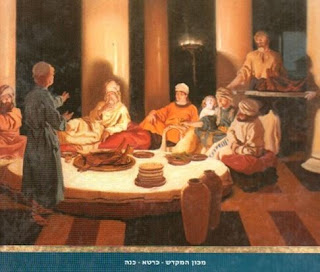Posted: 12 Apr 2016 12:05 PM PDT
 |
The Temple Institute's depiction of a Passover seder at
the time of the Temple. Note the pascal lamb on the table.
|
The Library of Congress photographic collection includes a series of photographs of Yemenite residents of Jerusalem celebrating their Passover seder in 1939. Note their low table and compare it to the painting of a Seder during the time of the Temple, taken from the Passover Seder Haggadah of the Temple Institute in Jerusalem.
In 1882, the Christians of the American Colony adopted a wave of Yemenite Jews who arrived in Jerusalem penniless, hungry and sick. The Colony believed the Jews were from the lost tribe of Gad. For decades the American Colony photographers continued to take pictures of the Yemenite community.
 |
| Yemenite Passover Seder: Drinking wine in the Kiddush ceremony. Note the table is covered at that point, and all men are leaning to their left as prescribed. (Library of Congress) |
 |
| Yemenite Passover Seder, eating the bitter herbs (1939) |
 |
| Washing hands during the Seder. Note the children's involvement and wonderment. A major theme of the Seder is to teach the children about the Exodus from Egypt. |
 |
| Passover meal. Note the square matza |
The Yemenite community has a tradition of a soft matza, similar to Middle East pita or laffa bread, which they bake daily during Passover.
Discussing the local Yemenite matza, an ancient traveler to Tza'ana in Yemen quoted his Yemenite host, "There is no requirement that the matzos be dry and stale because they were baked many days before Pesach. Every day we eat warm, fresh matza. "
The traveler reported, "I enjoyed their special kind of matza -- it was warm, soft and didn't have the usual burnt sections which was present in every matza I had ever eaten until then."

No comments:
Post a Comment